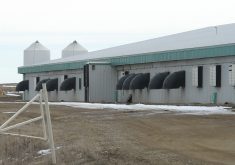Replacement of commercial nitrogen fertilizers with legume green manures could improve cropping sustainability and reduce the environmental footprint of a range of agricultural production systems.
Nitrogen fertilizer production is the single largest user of fossil fuel in conventional agricultural systems.
Legume green manures already play a pivotal role in organic cropping and might find a role beyond a small number of agricultural producers, especially as prices for conventional products rise along with energy prices.
A single season of a legume green manure on the Canadian Prairies can generally provide a large portion of the nitrogen needed for two subsequent crops if they are managed for that purpose.
Read Also

Phosphate prices to remain high
Phosphate prices are expected to remain elevated, according to Mosaic’s president.
Rhizobium bacteria partner with legumes, drawing nitrogen from the air and supplying it to the plant in a form it can use.
Most of the nitrogen is removed with the seed if the legume matures and is harvested.
However, the plant material is returned to the soil in a green manure, preferably before seeds are formed. The nitrogen cycles through soil organisms, but it remains in forms that plants are able to use.
The amount of nitrogen in a green manure depends on the amount of plant material that is produced.
Martin Entz of the University of Manitoba suggests that 525 to 4,450 kilograms per acre of plant matter can be produced per green manure crop, depending on available moisture.
There are generally 25 to 30 grams of nitrogen in one kg of legume plant material, meaning that green manures can supply 13 to 135 kg per acre of nitrogen.
At this rate, green manure is an investment in future years, which has limited its widespread adoption. In hard times and when cash flow is difficult, it is hard to invest in tomorrow, no matter how useful that might be.
Entz is rethinking green manures to help solve this problem.
Grazed green manure systems improve the economics and cash flow by adding livestock feeding income in the green manure year.
Theoretically, livestock and green manure make an excellent combination.
Livestock convert legume forage to meat, which can be marketed in the grazing year.
However, they also excrete most of the nutrients they consume in forms that plants are immediately able to use.
In this way, grazing increases the rate at which nutrients cycle.
Potential benefits of grazing include improved nitrogen and phosphorus cycling and improved soil bacterial diversity.
Grazing can be used to terminate green manures, which replaces tillage, and can also be an excellent weed control option.
However, a number of compatibility issues need to be resolved, including finding green manure options with good forage quality and palatability and dealing with anti-nutritional issues related to certain crops.
Nutrients are not deposited evenly during grazing. Possible solutions would be to use smaller livestock or to surface till to even out nutrient levels across a field.
Entz and his team have begun testing options at the university’s research facility near Carman, Man.
The test crops are oats as a non-legume control, a pea and oat mixture, black lentils, hairy vetch, soybeans and cowpea.
Entz is comparing grazing the forage green manures with sheep and terminating them using the roller-crimper followed by disking.
Sheep grazed all of the forage green manures, although they took a few days to develop a taste for lentils.
All the legumes were effectively killed by the grazing, but oats were not.
The researchers concluded that intensive grazing can be an option for terminating green manures without tillage.
Entz found that the nitrogen available in the soil in the grazed plots was twice as high after grazing than after green manures were killed mechanically. The extra available nitrogen was mostly in the surface layers.
In some soil, extra nitrogen can be lost before seeding the following spring. Entz recommended planting a catch crop, such as a winter cereal, to capture the available nitrogen before it leached away.
Another option would be to use a cereal and legume intercrop for a green manure. The legume would be killed by the initial grazing.
A grazing-tolerant cereal such as spring seeded winter triticale might survive, as the oats did, and regrow after grazing. This would allow it to capture the available nitrogen and make late season or winter grazing possible.
The Carman study is ongoing.
In other regions, grazing has increased income from green manures by $10 to $64 per acre.
The costs of adding grazing include extra infrastructure such as fencing and increased labour.
The benefits, including a marketable product, ecological goods and services, soil health and weed management, make grazed green manures worth considering, especially if there are already livestock on the farm or if custom grazing is a viable option.
Brenda Frick, Ph. D., P. Ag. is an extension agrologist and researcher in organic agriculture. She welcomes your comments at 306-260-0663 or email















